You are using an out of date browser. It may not display this or other websites correctly.
You should upgrade or use an alternative browser.
You should upgrade or use an alternative browser.
YES: RV Solar/ Li/ and AC running full time
- Thread starter Generis
- Start date
Generis
It'll be fun they said
I'll do some averaging here for you, because I don't have a watt meter on the single appliance.Any idea how many watts it uses over a 24 hour period ... when in temps between 83F - 94F over the 24 hour period and the AC temp set at 73F.
If I'm using 25a when it's running maintenance, and in the ON state, making cold, ON cycle. Let's average that run activity for 10 hours,
-Runs 25a for one hour, that's 25ah, x 10 hours, that's 250ah, 3350w total consumed.
and then let's assume it's slightly less during non-sun hours, and it runs a bunch overnight.. on and off, but generally still cooling most of the time, so...
-at night it runs 20a draw for another 10 hours, 20ah x 10hr is 200ah, 2680w consumed overnight.
Let's add this all up, and then make some guesses:
-Day use 250ah, 3350w.
-Night use 200ah, 2680w.
Now lets add in some reality.. .I DO in fact know that most I've ever consumed in power over night at this temp range is around 100 ah after the solar stopped.. so that's my total load, but let's assume it's mostly AC. Then, let's also admit that the unit doesn't run ALL THE TIME during the day, it's cycling on and off, so we will discount that load number as well...
-(Day use 250ah, 3350w.) if it runs 80% of the time, that's now 200ah, 2680w used during the day.
-(Night use 200ah, 2680w.) considering I've only seen half this usage, let's cut this in half. 100ah, 1340w night use.
Now we have a realistic estimate... We are burning up 4020w of power to run this setup over 24hrs at your temp range of "between 83F - 94F over the 24 hour period and the AC temp set at 73F."
Let's also assume I can generate 800w per hour on solar. And assume I'm going to eat the ENTIRE system load of the AC, 4020w using solar. IF this is true, here's the math:
-4020w / 800w = 5.025 hours of 800w production from the solar per 24hr period to satisfy the AC load.
This also has some other interesting notes... now that we're down this trail this far.. our load math has asked us for 300ah of battery to eat this AC load for a 24hr period. Let's assume you don't charge at ALL in that period, you're going to consume 300ah of battery to keep that load running. I do believe this is realistic, considering my actual numbers in my unit and my experience with it.
This would lead be to have storage well beyond this 300ah capacity, and I do have 550ah of lithium on hand.
I hope this helps
Chris
chrisski
Solar Boondocker
- Joined
- Aug 14, 2020
- Messages
- 5,171
I think the numbers you gave are good for a 25’ class c.
In temps you mentioned, I am parked in the sun and my AC will not cycle off until the sunsets so my power usage would be greater.
Whether in the shade, amount of insulation, and how much you open the door.
This thread has gotten me thinking if it’s possible for my situation with about 400 - 600 AH of lithium batteries at 24 volts. I already have 1350 watts of panels, Going to spend some time thinking what I need to complete this.
In temps you mentioned, I am parked in the sun and my AC will not cycle off until the sunsets so my power usage would be greater.
Whether in the shade, amount of insulation, and how much you open the door.
This thread has gotten me thinking if it’s possible for my situation with about 400 - 600 AH of lithium batteries at 24 volts. I already have 1350 watts of panels, Going to spend some time thinking what I need to complete this.
Generis
It'll be fun they said
I agree with you. It's working great in my C at 25'. True. Also true I have zero shade. No awning, no trees, nothing. Sitting on the lane black top all day in the sun. So far so go, I'll keep an eye on it. Very happy so far, but if nothing else, it's certainly possible, and with some tuning to your own rig and demands, it could be replicated successfully.I think the numbers you gave are good for a 25’ class c.
In temps you mentioned, I am parked in the sun and my AC will not cycle off until the sunsets so my power usage would be greater.
Whether in the shade, amount of insulation, and how much you open the door.
This thread has gotten me thinking if it’s possible for my situation with about 400 - 600 AH of lithium batteries at 24 volts. I already have 1350 watts of panels, Going to spend some time thinking what I need to complete this.
caymaanedge
New Member
- Joined
- Jul 19, 2020
- Messages
- 124
Can you clarify the Amperage draw numbers? You show 25a for am hour or 25ah. When converting 120v AC to 12v DC 25a of DC is around 2.5a of AC. Is the unit drawing that little power?I'll do some averaging here for you, because I don't have a watt meter on the single appliance.
If I'm using 25a when it's running maintenance, and in the ON state, making cold, ON cycle. Let's average that run activity for 10 hours,
-Runs 25a for one hour, that's 25ah, x 10 hours, that's 250ah, 3350w total consumed.
and then let's assume it's slightly less during non-sun hours, and it runs a bunch overnight.. on and off, but generally still cooling most of the time, so...
-at night it runs 20a draw for another 10 hours, 20ah x 10hr is 200ah, 2680w consumed overnight.
Let's add this all up, and then make some guesses:
-Day use 250ah, 3350w.
-Night use 200ah, 2680w.
Now lets add in some reality.. .I DO in fact know that most I've ever consumed in power over night at this temp range is around 100 ah after the solar stopped.. so that's my total load, but let's assume it's mostly AC. Then, let's also admit that the unit doesn't run ALL THE TIME during the day, it's cycling on and off, so we will discount that load number as well...
-(Day use 250ah, 3350w.) if it runs 80% of the time, that's now 200ah, 2680w used during the day.
-(Night use 200ah, 2680w.) considering I've only seen half this usage, let's cut this in half. 100ah, 1340w night use.
Now we have a realistic estimate... We are burning up 4020w of power to run this setup over 24hrs at your temp range of "between 83F - 94F over the 24 hour period and the AC temp set at 73F."
Let's also assume I can generate 800w per hour on solar. And assume I'm going to eat the ENTIRE system load of the AC, 4020w using solar. IF this is true, here's the math:
-4020w / 800w = 5.025 hours of 800w production from the solar per 24hr period to satisfy the AC load.
This also has some other interesting notes... now that we're down this trail this far.. our load math has asked us for 300ah of battery to eat this AC load for a 24hr period. Let's assume you don't charge at ALL in that period, you're going to consume 300ah of battery to keep that load running. I do believe this is realistic, considering my actual numbers in my unit and my experience with it.
This would lead be to have storage well beyond this 300ah capacity, and I do have 550ah of lithium on hand.
I hope this helps
Chris
Generis
It'll be fun they said
Yes. Watch the video in the first post. I'm not making this up.
aangel
New Member
- Joined
- Aug 12, 2020
- Messages
- 97
This is inspiring me to get rid of my overhead a/c unit, which does the job but is loud, the fan always blows at a high speed (even when set on low) and requires shore power or my generator to run it. The key is these inverter mini-splits that have high SEERs...they are so efficient and they have a variable fan speed.
Generis
It'll be fun they said
Yes sir. I started this project for the same reasons, and I'm very glad I did.This is inspiring me to get rid of my overhead a/c unit, which does the job but is loud, the fan always blows at a high speed (even when set on low) and requires shore power or my generator to run it. The key is these inverter mini-splits that have high SEERs...they are so efficient and they have a variable fan speed.
aangel
New Member
- Joined
- Aug 12, 2020
- Messages
- 97
I've begun my research, thank you for the inspiration!Yes sir. I started this project for the same reasons, and I'm very glad I did.
This is where I am so far. Sharing my thinking to collect my thoughts, in case it helps someone else and, of course, to get additional ideas.
Requirements
- be able to handle cooling a 23ft Class C at 94°F in full sun for 12 hr then 80°F for 12 hr without turning on the generator; this should handle Utah, Arizona, etc.
- quiet operation (don't want that loud, obnoxious a/c on anymore!)
- Optional: see what's required to run the fridge, which takes 2.75 amps 300W AC
- Include all losses from cables, inverter, etc.
- Connect panels so that if one panel is shaded it doesn't interrupt the whole system; must be careful if I go with tilting (which I'd like to do).
Strategy (at this point in time)
- Cover the roof with solar panels to shield it as much as possible from the sun. This recent build used stand-offs, which is a possibility, but I'm going to look into tilting systems, too, since getting 25% to 40% extra power is no joke.
- Use a high-SEER mini-split, minimum 19.
- Increase battery bank from current 200 amp•hr to ____ (to be determined).
- Attempt to reuse the hole from the current 13,500 ceiling a/c unit that will be removed.
12K BTU Mini-Split
- A 19 SEER system can be bought at the $800 level (example: Senville SENL-12CD Mini Split Air Conditioner Heat Pump, 12000 BTU 19 SEER)
- A 22 SEER system can be bought at the $950 level (example: 12k BTU 22 SEER MrCool Olympus Hyper Heat Ductless Heat Pump Split System)
- A 29 SEER system can be bought at the $1950 level (example: Fujitsu 12,000 BTU 29.3 SEER Ductless Mini-Split Heat Pump System)
Compressor will be placed on or above the rear bumper.
I'd love there to be an interior cassette that attaches to the ceiling as that would be ideal for even distribution in my small rig (plus it would reuse the hole already there).
Battery Bank
I currently have just one 200 amp•hr Ampere Time battery. This needs to go up to at least 400 amp•hr and likely 600 amp•hr. Have to do the calculations. The battery I bought is already $200 less than what I paid six months ago ($800 vs $1k).Inverter
Already have a Giandel 2200W Inverter installed, don't want to change it if I don't need to but switching to a Victron unit may be necessary for the monitoring system to be fully integrated.Converter
Already have a Progressive Dynamics 60 amp lithium converter installed, no change needed.Transfer Switch
Already have the Go Power! TS-30 30 Amp Automatic Transfer Switch installed, no change needed.Solar Charge Controller
Looking at the Victron SmartSolar MPPT 100/30 & 100/50.Solar Panels
The Trina 410W monocrystallines look nice and they are down to just $212 each (June 2021). I remember looking at solar 15 years ago and this price is astounding to me: $9/W down to under $1/W.However, this Victron video and this Victron video recommend using smaller panels rather than larger panels. The explanation makes sense; now I have to figure out how to calculate the optimum size.
Solar Panel Tilting System
Here is the manual, variable Renogy kit that is very affordable and here is a fancy, automatic tilting kit.Battery Monitor/Shunt
Looking at the Victron Energy SmartShunt 500 amp Battery Monitor (Bluetooth).Monitoring System
Looking at the Victron Cerbo GX.Outstanding Questions
- What's the optimal size of solar panel to maximum solar collection? See the Solar Panel section, above.
- What's the power usage of the mini-splits at each SEER?
- How much more battery do I add? It will probably be 400 amp•hr but I'll do the calculations.
Last edited:
Generis
It'll be fun they said
Excellent thought and planning here. I'm going to take a day and see all your links, so I can reply with sense.
aangel
New Member
- Joined
- Aug 12, 2020
- Messages
- 97
I would love your input!Excellent thought and planning here. I'm going to take a day and see all your links, so I can reply with sense.
And I've continued my research. It turns out there are mini-splits with a roof cassette. I really didn't want to remove or cut into a cabinet, if it could be avoided, while leaving a covered hole in the ceiling. The ceiling cassette below appears to be designed for indoor use i.e. the black portion that reaches above the ceiling may not be ready for outside weather.
Plus, they are a bit more expensive. Perhaps it's a bit more work to get everything to fit in the confined space. Moreover, I imagine they don't manufacture as many of them as the typical wall-mount design. The extra cost isn't that much, though, and the ability to reuse the ceiling hole means less installation work but only if it's easy to protect the part that sticks above the roof.
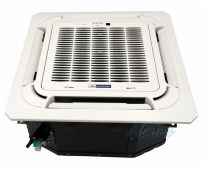
- 12,000 BTU (1 Ton) 23 SEER Single Zone Ceiling Cassette Ductless Mini Split System- WiFi Capable ($1339, June 2021)
- 12,000 BTU (1 Ton) 21 SEER Single Zone Concealed Duct Mini Split System ($1272, June 2021)
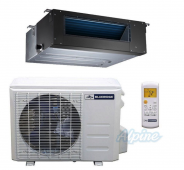
This page has some advice on how to select and install a ceiling cassette. They point out that:
- 10" to 12" are needed above the ceiling
- The space must be conditioned or condensation will form and drip into the living space
- Some units can be connected to a fresh air intake, if fresh outside air is desired
Turns out there is: it's called the "suspended ceiling mount" style. Fujitsu has this one but since it's 36k BTU it's not an option (though it looks great):

This Pioneer one is 18K BTU ($1828, June 2021) and is designed to work against the wall or suspended from the ceiling. Getting there...

This post discusses how to select a suspended ceiling mount cassette. It recommends:
- Do not suspend them in the middle of the ceiling. Instead, they should be installed against an exterior wall for two main reasons:
- So the air flow can reach across the entire room rather than just half.
- So you can run the connecting wire, line set, and drain tube directly through from the outside condenser via a 3-inch hole.
As for running the tube from the outside wall that should not be an issue. There's nothing stopping me from running the tube up the RV from the rear and across the roof. It's a bit of a long run but should be doable.
The post also mentions:
"Some ceiling suspended mini splits offer universal mounting capability, allowing you to suspend them from a ceiling or mount it on the bottom of a wall. However, the universally mountable units are typically not capable of throwing air as far as units strictly designed for ceiling suspension."
Ok, good to know: get the suspended ceiling mount only. However, I'm not finding a 12K BTU unit that's ceiling only; all suspended ceiling (only) units seem to start at 18K BTU.Like this Fujitsu model for $1854 (June 2021):
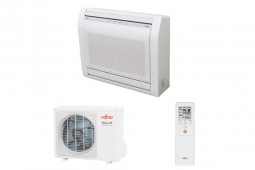
As a backup, there is this Senville floor mounted unit. It's SEER 23, can be ordered with 25ft or more of tubing and costs $1299, so it might make the short list even if tall people have to duck a bit.

What I really want is one that's this crazy-thin (Fujitsu - 18k BTU Cooling + Heating - Universal Floor/Ceiling Air Conditioning System)—but that doesn't cost $2500:
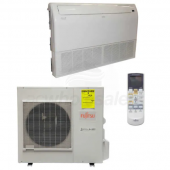
After over two hours of searching, I think the next step is to contact Senville and ask if they recommend against mounting their unit on the ceiling. I just can't seem to find a suspended ceiling unit at the BTU/price point I'm looking for. I suppose I could possibly spring for the Pioneer if the Senville is just too thick or can't be mounted on the ceiling. Solar panel costs have come down so much that the money I would have spent on them can go into this device.
frthompson
New Member
- Joined
- May 29, 2021
- Messages
- 62
It would be nice if there was a mini split with an outside unit that laid flat like the roof mount ac units on RVs so it could go on the roof.
Generis
It'll be fun they said
Well, there's a 12v domestic 'split' now that replaces the roof AC...and it's quiet...

 www.nomadiccooling.com
.. and this is the least amount of work ever....
www.nomadiccooling.com
.. and this is the least amount of work ever....

Dometic CoolAir 2000 RTX 12V | Nomadiccooling
PLEASE NOTE: THIS PRODUCT IS CURRENTLY IN STOCK AND READY TO ROCK. AVAILABLE FOR PICKUP SAME DAY, OR SHIPPING NEXT DAY! The RTX Truck Parking Cooler comes with an entirely new technology to continue a unique success story. CoolAir compressor parking coolers have been around for over ten years...
 www.nomadiccooling.com
www.nomadiccooling.com
Partimewages
Solar Addict
The mini splits don't have to push air through the inefficient ceiling ductwork. That likely adds 20% to the load of the RV.This is inspiring me to get rid of my overhead a/c unit, which does the job but is loud, the fan always blows at a high speed (even when set on low) and requires shore power or my generator to run it. The key is these inverter mini-splits that have high SEERs...they are so efficient and they have a variable fan speed.
aangel
New Member
- Joined
- Aug 12, 2020
- Messages
- 97
@frthompson true, that would be good, too. I wonder if the exterior unit needs to be horizontal. I'll ask this week when I talk to some manufacturers and retailers. Maybe all it needs is some clearance and it actually could lie horizontal. Or maybe it won't drain properly. ?
@Generis that's a nice unit but I got the impression it wasn't a split i.e. it's a regular (though quiet) air conditioner that happens to run on 12VDC. It also seems targeted to vans and truck cabs because it's only 2000W—and they are asking $2700 for it. I can get the Pioneer 18k BTU, which has almost three times the cooling capacity (5,272 W) for about $800 less. I don't think 2000W would work with my rig. I think I need at least double that for direct sun, hence why I'm looking at the 12,000 BTU units (3,520 W).
@Partimewages I would wager you're correct. At the same time, I have a small, older rig and my single unit air conditioner doesn't either; I have the very common Coleman TSR Dometic 13500 BTU unit ceiling mount unit. Too bad it's so loud and the fan is always on. It actually does cool well still.
@Generis that's a nice unit but I got the impression it wasn't a split i.e. it's a regular (though quiet) air conditioner that happens to run on 12VDC. It also seems targeted to vans and truck cabs because it's only 2000W—and they are asking $2700 for it. I can get the Pioneer 18k BTU, which has almost three times the cooling capacity (5,272 W) for about $800 less. I don't think 2000W would work with my rig. I think I need at least double that for direct sun, hence why I'm looking at the 12,000 BTU units (3,520 W).
@Partimewages I would wager you're correct. At the same time, I have a small, older rig and my single unit air conditioner doesn't either; I have the very common Coleman TSR Dometic 13500 BTU unit ceiling mount unit. Too bad it's so loud and the fan is always on. It actually does cool well still.
richard cabesa
New Member
- Joined
- Mar 16, 2021
- Messages
- 175
Input incomingI would love your input!
After over two hours of searching, I think the next step is to contact Senville and ask if they recommend against mounting their unit on the ceiling. I just can't seem to find a suspended ceiling unit at the BTU/price point I'm looking for. I suppose I could possibly spring for the Pioneer if the Senville is just too thick or can't be mounted on the ceiling. Solar panel costs have come down so much that the money I would have spent on them can go into this device.
I have probably 50 hours of research into these units and project manage in the building trades so I have seen many of these units go in and work with the techs that install them.
First problem with all of the units you have brought up is that they all run on 230 volt a new inverter is the first thing you have to ADD to your system. I say add because you will probably still want your 115 volt to supply your outlets and a microwave?
The recessed ceiling mount you have shown needs a 22-12" hole in your roof and then a water tight cover to protect it. They are not made to be exposed to any kind of elements.
I wish in all my dreams that that suspended unit was as small as they make it look in the pictures. It is over 50" long ad 26" deep, and 10" tall. Just no way anywhere in my rig
The other described wall/floor mount units are all 230V also and all quite large.
Your last unit listed, the exterior unit is HUGE
Another thing to keep in mind is that higher BTU units don't always idle down to as low of BTU as the smaller units and that 38 SEER may not be as efficient as the 22 SEER that slows down to 3500BTU once a temp is achieved
Another thing your may find is a lack of reception if you wonder into an HVAC shop to ask questions.
Basic answer is "they are not for mobile use"
That is not going to stop me though. I have my eye on the 115 V Pioneer 9K Inverter++21.5 SEER model. Won't happen until this winter when we have no trips planned, and of course don't need AC then
Last edited:
chrisski
Solar Boondocker
- Joined
- Aug 14, 2020
- Messages
- 5,171
I wonder what the feedback will be once there's more of these mini splits popping up on RVs. I do worry about a bumper mount if I install one. Those bumpers do bounce a lot.Basic answer is "they are not for mobile use"
aangel
New Member
- Joined
- Aug 12, 2020
- Messages
- 97
Thanks for pointing that out (the 240VAC), @richard cabesa ; I made an assumption they were 120VAC. Yes, I will need another inverter, unfortunately, if I go with a ceiling mount. I'm also going to need to figure out what the minimum and maximum draws on those units are. And the exact dimensions. I'm not deterred yet.
And will need to look at how to fill that hole where the AC unit currently is; someone posted a link to a youtube channel that seems to specialize in showing how to do that so I'm hoping that will give me ideas.
I actually may have two holes to fill. I just made a layout of my roof while I had sunlight and to get over 1kW I need the space currently occupied by the air conditioner and the vent. If I use stand-offs, I should get away with just putting the solar panels overtop the front vent, saving me some work. But it seems likely the A/C unit has got to go. Have to see how the power requirement calculations work out.
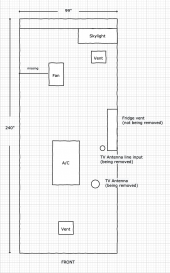
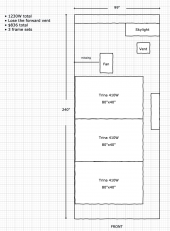
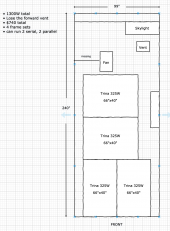
I can fit 3 of the larger Trina panels and 4 of the slightly smaller ones with the A/C removed. From what I've been reading on this site, I likely want to go with the smaller panels since I can hook 2 sets of them up in series and then the sets in parallel, allowing me to use thinner cables while still isolating sets in case of shade. Plus, those Victron videos recommended preferring smaller panels to get more usable hours of sun in the day.
With the 4 panel setup, it looks to me that I could still tilt the two rear panels if I wanted to and the driver-side front panel (yes, front is at the bottom; it came from how I was sitting on the A/C unit when taking the measurements).
Next up are some power requirement calculations; sometime this week, I expect.
And will need to look at how to fill that hole where the AC unit currently is; someone posted a link to a youtube channel that seems to specialize in showing how to do that so I'm hoping that will give me ideas.
I actually may have two holes to fill. I just made a layout of my roof while I had sunlight and to get over 1kW I need the space currently occupied by the air conditioner and the vent. If I use stand-offs, I should get away with just putting the solar panels overtop the front vent, saving me some work. But it seems likely the A/C unit has got to go. Have to see how the power requirement calculations work out.



I can fit 3 of the larger Trina panels and 4 of the slightly smaller ones with the A/C removed. From what I've been reading on this site, I likely want to go with the smaller panels since I can hook 2 sets of them up in series and then the sets in parallel, allowing me to use thinner cables while still isolating sets in case of shade. Plus, those Victron videos recommended preferring smaller panels to get more usable hours of sun in the day.
With the 4 panel setup, it looks to me that I could still tilt the two rear panels if I wanted to and the driver-side front panel (yes, front is at the bottom; it came from how I was sitting on the A/C unit when taking the measurements).
Next up are some power requirement calculations; sometime this week, I expect.
richard cabesa
New Member
- Joined
- Mar 16, 2021
- Messages
- 175
I’m going to say, don’t bother tilting. I have 200 of my 800 watts that is tillable. Very rarely do I do anything other than deploy it flat with the rest.
yes. I can drag another —200 watt/hrs out of it in a day, but really, I’d rather do something else with my time.
yes. I can drag another —200 watt/hrs out of it in a day, but really, I’d rather do something else with my time.
richard cabesa
New Member
- Joined
- Mar 16, 2021
- Messages
- 175
As far as that old 14x14 hole in the roof?
Another fan and make sure it is reversible. InOut fans and you won’t need the AC as much anyway
Another fan and make sure it is reversible. InOut fans and you won’t need the AC as much anyway
Similar threads
- Replies
- 36
- Views
- 797
- Replies
- 15
- Views
- 938
- Replies
- 5
- Views
- 295
- Replies
- 6
- Views
- 780


